Abstract
1 The mechanism of the cataleptic effect of metoclopramide was analyzed by using drugs which alter the activity of dopaminergic or cholinergic neurones or the content of psi-aminobutyric acid in the central nervous system of rats. 2 The cataleptic effect of metoclopramide (20 mg/kg) was antagonized by apomorphine (10 mg/kg) and by atropine (50 mg/kg). Aminoxyacete acid (AOAA, 25-50 mg/kg) potentiated the catalepsy induced by metoclopramide (5 mg/kg). 3 Metoclopramide alone did not alter the rectal temperature of rats. It did not alter the AOAA-induced hypothermia, but it partially antagonized apomorphine-induced hypothermia. 4 Metoclopramide induced a six-fold increase in striatal homovanillic acid (HVA) concentration, but it did not change the dopamine or noradrenaline content in the brain of rats. Apomorphine decreased the striatal HVA concentration in control and in metoclopramide-treated rats. Atropine and AOAA did not alter the metoclopramide-induced increase in striatal HVA concentration. 5 The results suggest that metoclopramide produces catalepsy by blocking striatal dopamine receptors.
Full text
PDF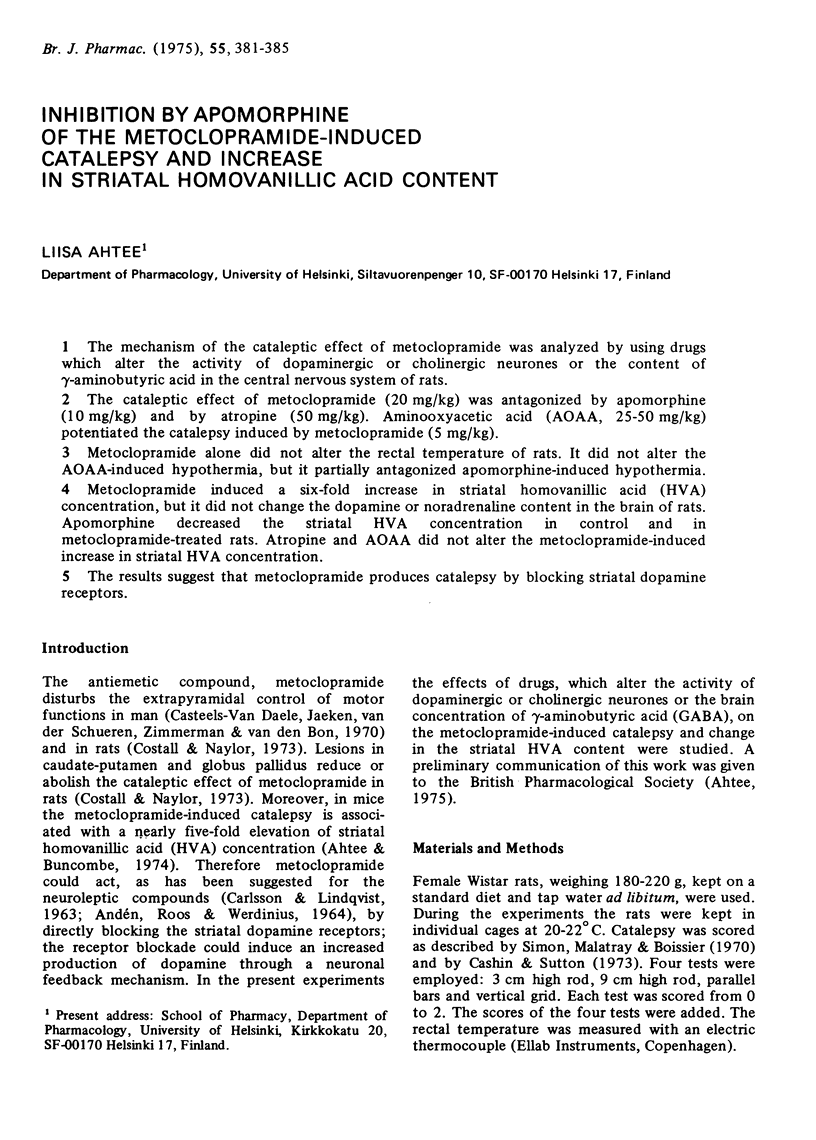
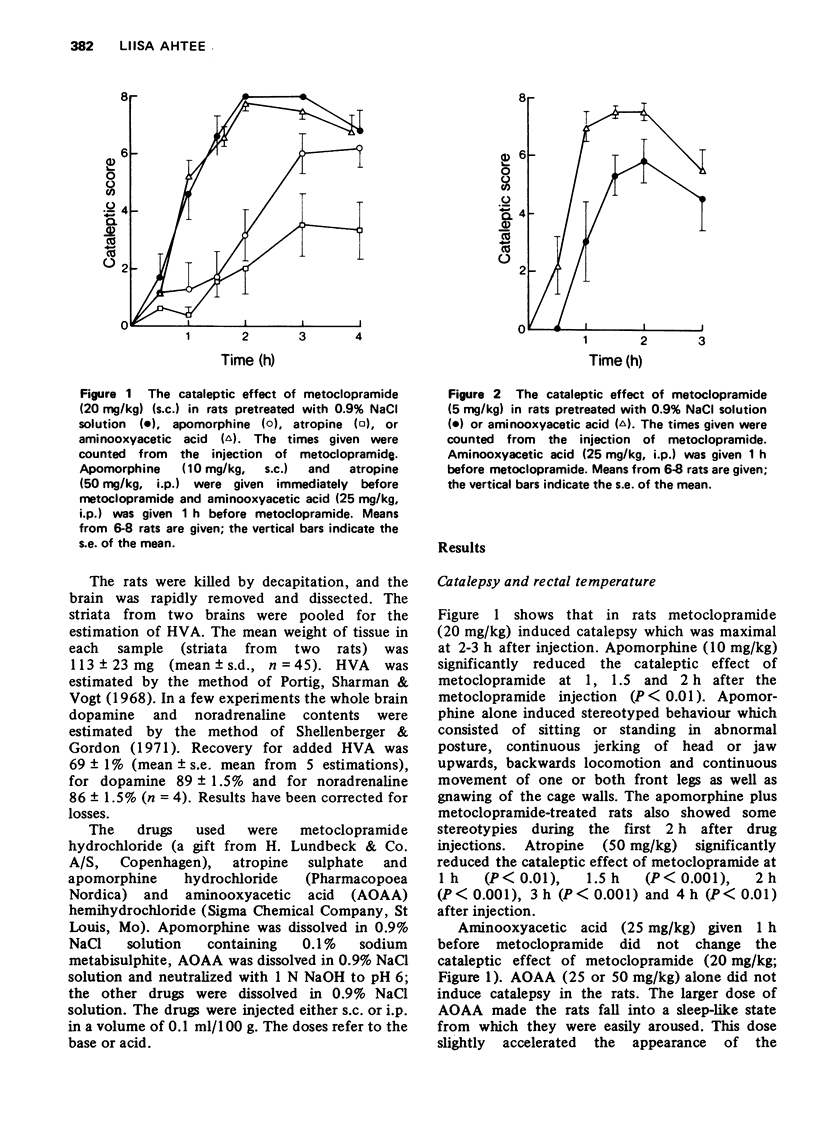
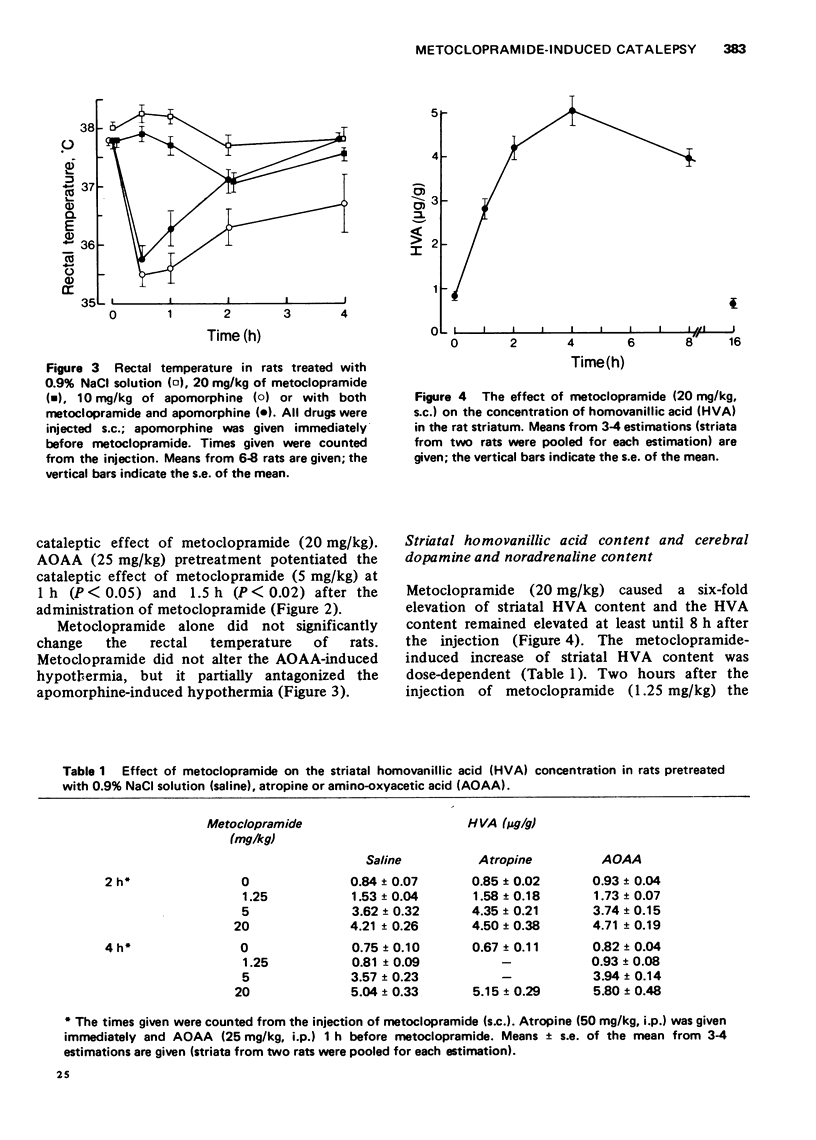
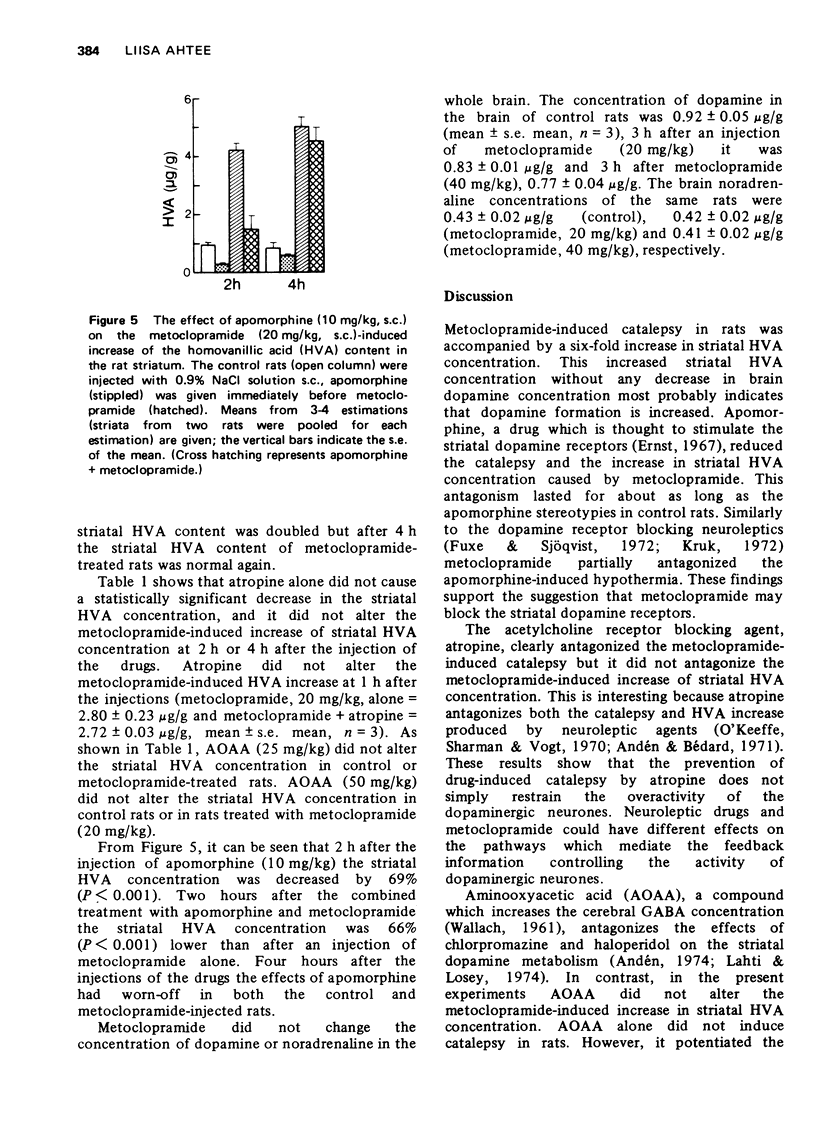
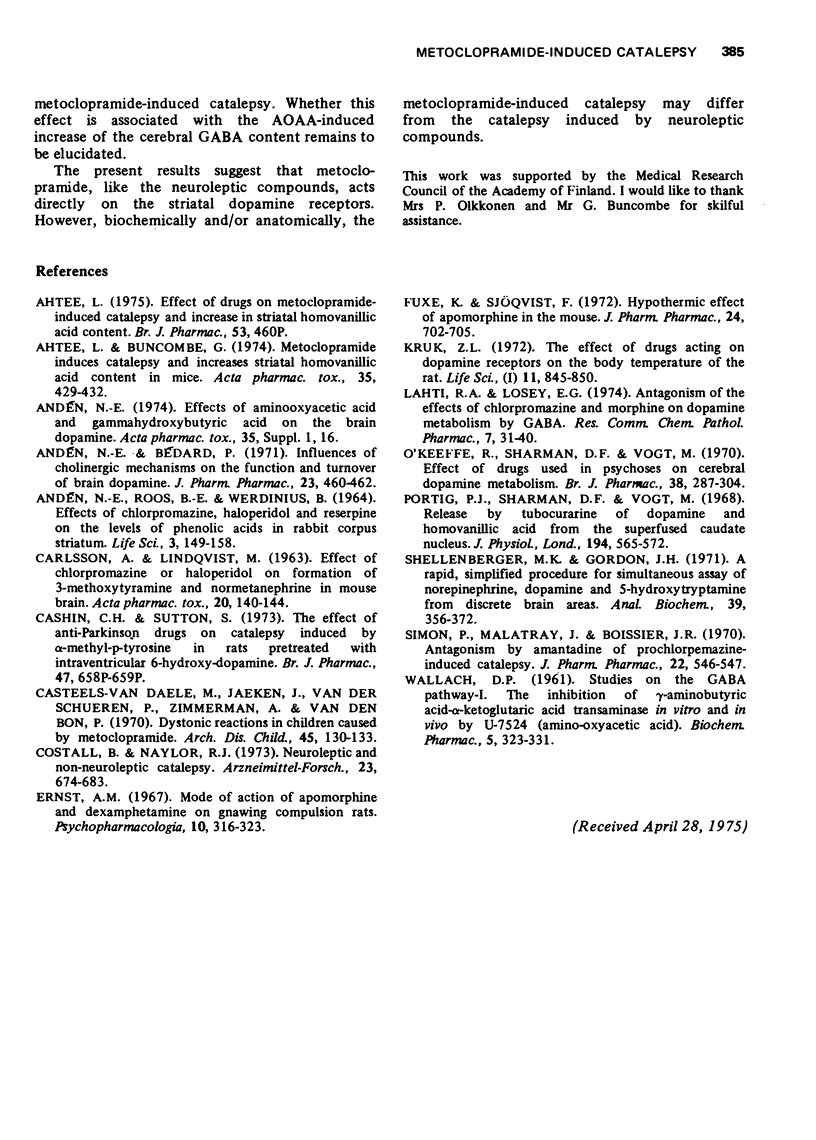
Selected References
These references are in PubMed. This may not be the complete list of references from this article.
- Ahtee L., Buncombe G. Metoclopramide induces catalepsy and increases striatal homovanillic acid content in mice. Acta Pharmacol Toxicol (Copenh) 1974 Nov;35(5):429–432. doi: 10.1111/j.1600-0773.1974.tb00764.x. [DOI] [PubMed] [Google Scholar]
- Ahtee L. Effect of drugs on metoclopramide-induced catalepsy and increase in striatal homovanillic acid content. Br J Pharmacol. 1975 Mar;53(3):460P–460P. [PMC free article] [PubMed] [Google Scholar]
- Andén N. E., Bédard P. Influences of cholinergic mechanisms on the function and turnover of brain dopamine. J Pharm Pharmacol. 1971 Jun;23(6):460–462. doi: 10.1111/j.2042-7158.1971.tb08686.x. [DOI] [PubMed] [Google Scholar]
- CARLSSON A., LINDQVIST M. EFFECT OF CHLORPROMAZINE OR HALOPERIDOL ON FORMATION OF 3METHOXYTYRAMINE AND NORMETANEPHRINE IN MOUSE BRAIN. Acta Pharmacol Toxicol (Copenh) 1963;20:140–144. doi: 10.1111/j.1600-0773.1963.tb01730.x. [DOI] [PubMed] [Google Scholar]
- Cashin C. H., Sutton S. The effect of anti-Parkinson drugs on catalepsy induced by -methyl-p-tyrosine in rats pretreated with intraventricular 6-hydroxydopamine. Br J Pharmacol. 1973 Mar;47(3):658P–659P. [PMC free article] [PubMed] [Google Scholar]
- Casteels-Van Daele M., Jaeken J., Van der Schueren P., Van den Bon P. Dystonic reactions in children caused by metoclopramide. Arch Dis Child. 1970 Feb;45(239):130–133. doi: 10.1136/adc.45.239.130. [DOI] [PMC free article] [PubMed] [Google Scholar]
- Costall B., Naylor R. J. Neuroleptic and non-neuroleptic catalepsy. Arzneimittelforschung. 1973 May;23(5):674–683. [PubMed] [Google Scholar]
- Ernst A. M. Mode of action of apomorphine and dexamphetamine on gnawing compulsion in rats. Psychopharmacologia. 1967;10(4):316–323. doi: 10.1007/BF00403900. [DOI] [PubMed] [Google Scholar]
- Fuxe K., Sjöqvist F. Hypothermic effect of apomorphine in the mouse. J Pharm Pharmacol. 1972 Sep;24(9):702–705. doi: 10.1111/j.2042-7158.1972.tb09093.x. [DOI] [PubMed] [Google Scholar]
- Kruk Z. L. The effect of drugs acting on dopamine receptors on the body temperature of the rat. Life Sci I. 1972 Sep 15;11(18):845–850. doi: 10.1016/0024-3205(72)90100-2. [DOI] [PubMed] [Google Scholar]
- O'Keeffe R., Sharman D. F., Vogt M. Effect of drugs used in psychoses on cerebral dopamine metabolism. Br J Pharmacol. 1970 Feb;38(2):287–304. doi: 10.1111/j.1476-5381.1970.tb08517.x. [DOI] [PMC free article] [PubMed] [Google Scholar]
- Portig P. J., Sharman D. F., Vogt M. Release by tubocurarine of dopamine and homovanillic acid from the superfused caudate nucleus. J Physiol. 1968 Feb;194(2):565–572. doi: 10.1113/jphysiol.1968.sp008425. [DOI] [PMC free article] [PubMed] [Google Scholar]
- Shellenberger M. K., Gordon J. H. A rapid, simplified procedure for simultaneous assay of norepinephrine, dopamine, and 5-hydroxytryptamine from discrete brain areas. Anal Biochem. 1971 Feb;39(2):356–372. doi: 10.1016/0003-2697(71)90426-x. [DOI] [PubMed] [Google Scholar]
- Simon P., Malatray J., Boissier J. R. Antagonism by amantadine of prochlorpemazine-induced catalepsy. J Pharm Pharmacol. 1970 Jul;22(7):546–547. doi: 10.1111/j.2042-7158.1970.tb10567.x. [DOI] [PubMed] [Google Scholar]
- WALLACH D. P. Studies on the GABA pathway. I. The inhibition of gamma-aminobutyric acid-alpha-ketoglutaric acid transaminase in vitro and in vivo by U-7524 (amino-oxyacetic acid). Biochem Pharmacol. 1961 Feb;5:323–331. doi: 10.1016/0006-2952(61)90023-5. [DOI] [PubMed] [Google Scholar]


